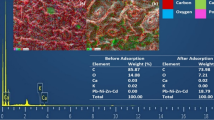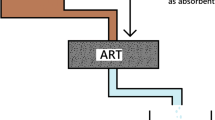Abstract
Removal of heavy metals (Cobalt, Cadmium, and Zinc) from waste water was possible using black teawaste. Adsorption was observed for the three metals at 180 min. Under our experimental conditions, pH plays an important role in the adsorption process, particularly on the adsorption capacity of teawaste for the heavy metals under study. The pH level allowing for an optimum rate of adsorption was found to be 6 for Co, Cd, and Zn. We demonstrate that black teawaste has a relatively high adsorption capacity for these heavy metals; the quantities adsorbed per a half gram of black teawaste at equilibrium (q e) are 15.39 mg/g for Co, 13.77 mg/g for Cd, and 12.24 mg/g for Zn. It was found that the percentage of removed metal ions is inversely proportional to initial metal ions concentration, but correlates with teawaste adsorbent dosage. The adsorption of heavy metals on black teawaste is described by an isotherm of type I and is fully verified by the Freundlich and Langmuir isotherms. The kinetics of the Cobalt, Cadmium, and Zinc adsorption on the teawaste were found to follow a pseudo first-order rate equation. This method has the advantage of being applicable in developing countries due to the low cost and availability of teawaste.

Similar content being viewed by others
References
Bakkaloglu I., Butter T.J., Evison L.M., Holland F.S., Hancock I.C.: Screening of various types biomass for removal and recovery of heavy metals (Zn, Cu, Ni) by biosorption, sedimentation and desorption. Water Sci. Technol. 38, 269–277 (1998)
Yetis U., Ozcengiz G., Filiz B., Ergen N., Erbay A., Dolek A.: Heavy metal biosorption by white-rot fungi. Water Sci. Technol. 38, 323–330 (1998)
Juang R.S., Shiau R.C.: Metal removal from aqueous solutions using chitosan-enhanced membrane filtration. J. Membr. Sci. 165(2), 159–167 (2000)
Iqbal M., Saeed A., Akhtar N.: Petiolar feltsheath of palm: a new biosorbent for the removal of heavy metals from contaminated water. Bioresour. Technol. 81, 151–153 (2002)
Dakiky M., Khamis M., Manassra A., Mereb M.: Selective adsorption of chromium (VI) in industrial wastewater using low-cost abundantly available adsorbents. Adv. Environ. Res. 6(4), 533–540 (2002)
Espinola, A.; Adamian, R.; Gomes, L.M.B.: An innovative technology: natural coconut fiber as adsorptive medium in industrial wastewater cleanup. In: Proceedings of TMS Fall Extraction and Processing Conference 3, 2057–2066 (1999)
Juan C.M., Rigoberto G., Liliana G.: Removal of Mn, Fe, Ni and Cu ions from wastewater using cow bone charcoal. Materials 3, 452–466 (2010)
Marshall W.E., Champagne E.T.: Agricultural byproducts as adsorbents for metal ions in laboratory prepared solutions and in manufacturing wastewater. J. Environ. Sci. Health—Part A Environ. Sci. Eng. 30(2), 241–261 (1995)
Tarley T., Cesar R., Zezzi A., Marco A.: Biosorption of heavy metals using rice milling by-products. Characterization and application for removal of metals from aqueous solutions. Chemosphere 54(7), 905–915 (2004)
Saeed A., Iqbal M., Akhtar M.W.: Application of biowaste materials for the sorption of heavy metals in contaminated aqueous medium. Pak. J. Sci. Ind. Res. 45(3), 206–211 (2002)
Hossain M.A., MikioK., Yoshimasa M., Shigeru M.: Kinetics of Cr(VI) adsorption on used black tea leaves. J. Chem. Eng. Jpn. 38(6), 402–408 (2005)
Amarasinghe B.M., Williams R.A.: Tea waste as a low cost adsorbent for the removal of Cu and Pb from wastewater. Chem. Eng. J. 132(1), 299–309 (2007)
Yoshita A., Lu J.L., Ye J.H., Liang Y.R.: Sorption of lead from aqueous solutions by spent tea leaf. Afr. J. Biotechnol. 8(10), 2212–2217 (2009)
Antonio Z., Roberto L.: Adsorption of Pb(II) on spent leaves of green and black tea. Am. J. Appl. Sci. 7(2), 153–159 (2010)
Sunil K.B., Arti J.: Removal of copper(II) from aqueous solution using spent tea leaves (STL) as a potential sorbent. Water SA 36(3), 221–228 (2010)
Abdollahi, H.; Panahi, S.M.; Khoshayand, M.R.: Simultaneous spectrophotometric determination of iron, cobalt and copper by partial least-squares calibration method in micellar medium. Iran. J. Pharm. Res. 207–212 (2003)
Senthil P.K., Gayathri R.: Adsorption of Pb2+ ions from aqueous solutions onto Bael tree leaf: Isotherms, kinetics, and thermodynamics study. J. Eng. Sci. Technol. 4(4), 381–399 (2009)
Mamisahebei S., Jahed K., Torabian A., Nasseri S., Naddafi K.: Removal of arsenic from an aqueous solution by pretreated waste tea fungal biomass. Iran. J. Environ. Health. Sci. Eng. 4(2), 85–92 (2007)
Demirbas A.: Heavy metal adsorption onto agro-based waste materials: a review. J. Hazard. Mater. 157, 220–229 (2008)
Suwan C., Pachernchai C., Chutima S.: Removal of cadmium and nickel from aqueous solution by adsorption onto treated fly ash from Thailand. Thammasat Int. J. Sci. Tech. 1(l(2), 13–20 (2006)
Bodek, I.; Lyman, W.J.; Reehl, W.F.; Rosenblatt, D.H.: Environmental inorganic chemistry properties, processes and estimation methods. SETAC Special Publications Series. Pergamon Press, USA (1995)
Carrott P.J., Ribeiro C.M., Nabais J.M., Prates R.J.: Influence of surface ionization on the adsorption of aqueous zinc species by activated carbons. Carbon 35(3), 403–411 (1997)
Baes, C.F.; Messmer, R.E.: The hydrolysis of cations. Florida (1976)
Kailas L.W.: Adsorption of metals onto tea factory waste: a review. IJRRAS 3(3), 303–322 (2010)
Shukla S.S., Yu L.J., Dorris K.L., Shukla A.: Removal of nickel from aqueous solutions by sawdust. J. Hazard. Mater. B 121, 243–246 (2005)
Hall K.R., Eagleton L.C., Acrivos A., Vermeulen T.: Pore and solid diffusion Kinetics in fixed bed adsorption under constant pattern conditions. Ind. Eng. Chem. Fundam. 5, 212–223 (1966)
Ho Y.S., McKay G.: The sorption of lead(10) ions on peat. Water Res. 33, 578–584 (1999)
Author information
Authors and Affiliations
Corresponding author
Rights and permissions
About this article
Cite this article
Mohammed, R.R. Removal of Heavy Metals from Waste Water Using Black Teawaste. Arab J Sci Eng 37, 1505–1520 (2012). https://doi.org/10.1007/s13369-012-0264-8
Received:
Accepted:
Published:
Issue Date:
DOI: https://doi.org/10.1007/s13369-012-0264-8




